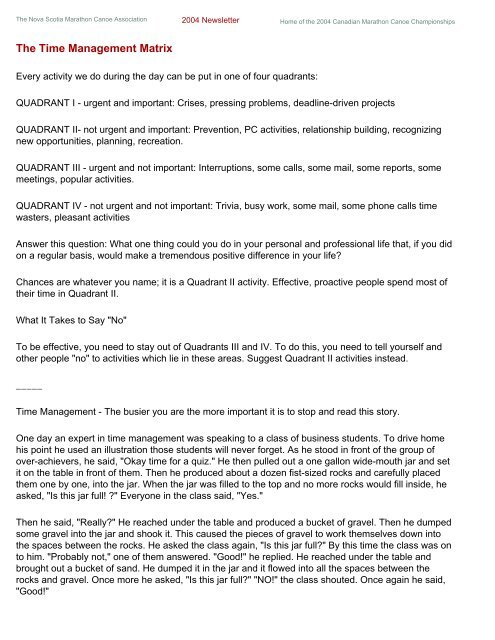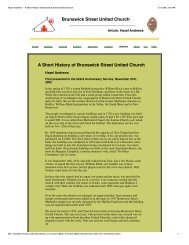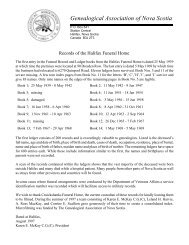N.S. Marathon Canoe Home Page - Chebucto Community Net
N.S. Marathon Canoe Home Page - Chebucto Community Net
N.S. Marathon Canoe Home Page - Chebucto Community Net
You also want an ePaper? Increase the reach of your titles
YUMPU automatically turns print PDFs into web optimized ePapers that Google loves.
The Nova Scotia <strong>Marathon</strong> <strong>Canoe</strong> Association 2004 Newsletter <strong>Home</strong> of the 2004 Canadian <strong>Marathon</strong> <strong>Canoe</strong> ChampionshipsThe Time Management MatrixEvery activity we do during the day can be put in one of four quadrants:QUADRANT I - urgent and important: Crises, pressing problems, deadline-driven projectsQUADRANT II- not urgent and important: Prevention, PC activities, relationship building, recognizingnew opportunities, planning, recreation.QUADRANT III - urgent and not important: Interruptions, some calls, some mail, some reports, somemeetings, popular activities.QUADRANT IV - not urgent and not important: Trivia, busy work, some mail, some phone calls timewasters, pleasant activitiesAnswer this question: What one thing could you do in your personal and professional life that, if you didon a regular basis, would make a tremendous positive difference in your life?Chances are whatever you name; it is a Quadrant II activity. Effective, proactive people spend most oftheir time in Quadrant II.What It Takes to Say "No"To be effective, you need to stay out of Quadrants III and IV. To do this, you need to tell yourself andother people "no" to activities which lie in these areas. Suggest Quadrant II activities instead._____Time Management - The busier you are the more important it is to stop and read this story.One day an expert in time management was speaking to a class of business students. To drive homehis point he used an illustration those students will never forget. As he stood in front of the group ofover-achievers, he said, "Okay time for a quiz." He then pulled out a one gallon wide-mouth jar and setit on the table in front of them. Then he produced about a dozen fist-sized rocks and carefully placedthem one by one, into the jar. When the jar was filled to the top and no more rocks would fill inside, heasked, "Is this jar full! ?" Everyone in the class said, "Yes."Then he said, "Really?" He reached under the table and produced a bucket of gravel. Then he dumpedsome gravel into the jar and shook it. This caused the pieces of gravel to work themselves down intothe spaces between the rocks. He asked the class again, "Is this jar full?" By this time the class was onto him. "Probably not," one of them answered. "Good!" he replied. He reached under the table andbrought out a bucket of sand. He dumped it in the jar and it flowed into all the spaces between therocks and gravel. Once more he asked, "Is this jar full?" "NO!" the class shouted. Once again he said,"Good!"







